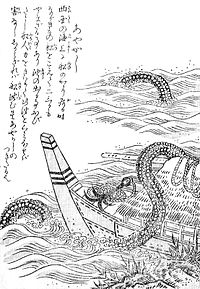Ikuchi

Ikuchi is a yōkai of the sea in legends of Japan. It is described in Tankai (譚海) by Sōan Tsumura and in Mimibukuro by Negishi Shizumori among other written works of the Edo Period.
Outline
According to "Tankai," in Hitachi Province (now Ibaraki Prefecture), the ikuchi is a strange fish that appears in the open sea, and it comes in contact with a boat once it discovers one, and even when it straddles the ship it is still able to pass, but since it has a body of several kilometers in length, it would require at least 12 koku (a little less than 3 hours) to pass it. From its body surface, an adhesive oil would seep out, and when it straddles the boat, it would spill a large amount of this oil on the ship, so if this is not scooped out, the boat would sink.[1]
In "Mimibukuro," it was written as "Ikuji," and it was stated to appear from time to time from the western sea to the southern sea (Kansai region and Kyushu), and they would get caught on the bow of the ship. It is unusually long like an eel (ikuji), so that it would take 2 or 3 days for the boat to pass it, and it was stated that the proverb "ikuji naki" came from this. From the same book, a certain character said, "in the sea of Hachijō, Zushū (now Hachijō-jima, Tokyo, there are what one might think are small eel, but it is actually an eel-like creature that goes around in a loop, and since it moves without eyes or a mouth, so when it gets caught on the bow of a ship, it is not moving by extending itself, but rather revolving around."[2]
In the entry "ayakashi" in Sekien Toriyama's Konjaku Hyakki Shūi, there is a drawing of a large sea snake, but it was drawn as ikuchi, an ayakashi (strange phenomenon of the sea).[3]
During the present Heisei period, there have been hypotheses proposed that they are not strange fish, but rather giant sea snakes,[4] or that they are humans who have drowned and want others to join them.[5] Sekien's yōkai drawing resemble a sea serpent, a cryptid, some have identified them to be the same.[6]
References
- ^ 津村淙庵 (2008). "譚海". In 柴田宵曲編 (ed.). 奇談異聞辞典. ちくま学芸文庫. 筑摩書房. pp. 32頁. ISBN 978-4-480-09162-8.
- ^ 根岸鎮衛 (1991). 長谷川強校注 (ed.). 耳嚢. 岩波文庫. Vol. 上. 岩波書店. pp. 357–358頁. ISBN 978-4-00-302611-3.
- ^ 村上健司編著 (2005). 日本妖怪大事典. Kwai books. 角川書店. pp. 25頁. ISBN 978-4-04-883926-6.
- ^ 人文社編集部 (2006). 日本の謎と不思議大全 東日本編. ものしりミニシリーズ. 人文社. pp. 55頁. ISBN 978-4-7959-1986-0.
- ^ 人文社編集部 (2005). 諸国怪談奇談集成 江戸諸国百物語 東日本編. ものしりシリーズ. 人文社. pp. 45頁. ISBN 978-4-7959-1955-6.
- ^ 山口敏太郎 (2007). 本当にいる日本の現代妖怪図鑑. 笠倉出版社. pp. 134頁. ISBN 978-4-7730-0365-9.
